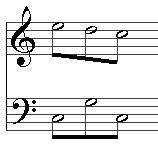Schenkerian analysis
|
|
Schenkerian analysis is an approach to musical analysis devised by Heinrich Schenker. It generates all tonal music from a simple progression based on the tonic triad which in its simplest form is:
This prototypical counterpoint, which Schenker called the Ursatz (see satz), consists of a melodic prototype (the "Urlinie") and a harmonic prototype (the "Bassbrechung"). The Urlinie is "a stepwise descent from one of the triad notes to the tonic (hence, 3-2-1, 5-4-3-2-1, 8-7-6-5-4-3-2-1)" (Middleton 1990, p.193). The bass arpeggiation is a two-stage progression: first moving from I to V and then from V back to I. Schenker came to understand every tonal work to be an embellishment of an Ursatz, giving precision to the claim that a tonal work unfolds in a particular triad or key.
Schenker defined tonal music as that of the masterpieces of the Baroque, Classical, and Romantic eras. According to Allen Forte, "Schenker's major concept is not that of the Ursatz, as it is sometimes maintained, but that of structural levels, a far more inclusive idea." Schenker called these levels Schichten. He called only the Ursatz background or Hintergrund and he called the foreground Vordergrund. (Beach 1983)
Schenker used traditional musical notation with modified implications, and his own symbols, on graphs or graphic analyses. Forte groups Schenker's graphs into "rhythmic" and "structural" types. In rhythmic reduction, often called metric reduction, the original note durations and their meanings are kept, while in structural analysis longer rhythmic values indicate greater structural importance or level. In Free Composition half notes, sometimes whole notes, are used for the fundamental line also accompanied by careted scale degree and its supporting bass. Quarter notes indicate middleground, linear progressions and their supporting bass lines, and eighth notes usually indicate embellishments or leading tone motion to the tonic. Beams and slurs connect and group together parts of the same structural level. Other symbols include those for interruptions and omissions. (Beach 1983)
While contemporary authors such as Forte and Beach present Schenker's analysis as a process of reducing a composition to an Ursatz, Schenker himself saw analysis as generating from the premise of an Ursatz (see Snarrenberg 1997).
Diminution
Other important concepts include diminution. In Schenkerian theory a diminution, or "division", rather than a diminishing is an expansion, "the process by which an interval formed by notes of longer value is expressed in notes of smaller value." Those notes of smaller value represent the notes of longer value, and thus the latter need not be present. A diminution may be classified as a passing note (P), neighboring note (N, upper or lower, complete or incomplete, direct or indirect), consonant skip (CS), arpeggiation (Arp). These are all also terms for nonchord tones, but Schenkerian analysis differentiates levels not expressed by the terms chordal and nonchordal tones. Diminutions may also be prefixes or suffixes. (Forte and Gilbert 1982)
"The function of a note is determined by its harmonic and contrapuntal setting." Thus whether a note is part of or a diminution is determined by its context. For example, if two adjacent notes alternate, the one which is 'unsupported' by the harmony is a neighboring note. (Forte and Gilbert 1982)
Schenkerian analysis uses its own form of notations, or creates successive notations of musical works. The first step is often a rhythmic reduction, removing some or all diminutions. Then the time signature and barlines are removed, with stems and slurs added. Slurs indicate dependency upon stemmed notes. (Forte and Gilbert 1982)
Further reading
- Jonas, Oswald (1982). Einführung in die Lehre Heinrich Schenkers: Das Wesen des musikalischen Kunstwerks. Translated by John Rothgeb. New York and London: Longman. "Most complete discussion of Schenker's theories." (Beach 1983)
- Summaries:
- Forte, Allen (1959). "Schenker's Conception of Musical Structure", Journal of Music Theory 3. (Beach 1983)
- Katz, Adele (1935). "Heinrich Schenker's Method of Analysis," The Musical Quarterly 31. (Beach 1983)
- Pedagogical works:
- Forte, Allen and Gilbert, Steven E. (1982). Introduction to Schenkerian Analysis. W. W. Norton & Company. ISBN 0393951928. Schenker never presented a pedagogical presentation of his theories, this being the first according to its authors.
- Snarrenberg, Robert (1997). "Schenker's Interpretive Practice." Cambridge: Cambridge University Press. ISBN: 0521497264.
- Cadwallader, Allen and Gagne, David (1998). Analysis of Tonal Music: A Schenkerian Approach. ISBN: 0195102320. The second.
- Expansions:
- Salzer, Felix (1952). Structural Hearing: Tonal Coherence in Music. New York: Charles Boni. "The first book to present a reorganization (as well as modification and expansion) of Schenker's writings from a pedagogical standpoint." Beach (1983)
- Yeston, Maury, ed. (1977). Readings in Schenker Analysis and Other Approaches. New Haven: Yale University Press.
- Beach, David, ed. (1983). Aspects of Schenkerian Theory. New Haven: Yale University Press.
- Pre-Baroque expansion:
- See Salzer's Structural Hearing above. (Beach 1983)
- Post-tonal expansion:
- Travis, Roy (1959). "Toward a New Concept of Tonality", Journal of Music Theory 3. (Beach 1983)
- Travis, Roy (1966). "Directed Motion in Schoenberg and Webern", Perspectives of New Music 4. (Beach 1983)
- Rhythmic expansions:
- Komar, Arthur (1971/1980). Theory of Suspensions: A Study of Metrical Pitch Relations in Tonal Music. Princeton: Princeton University Press/Austin, Texas: Peer Publications. (Beach 1983)
- Yeston, Maury (1976). The Stratification of Musical Rhythm. New Haven: Yale University Press. (Beach 1983)
- Criticism:
- Narmour, Eugene (1977). Beyond Schenkerism: The Need for Alternatives in Music Analysis. Chicago: The University of Chicago Press.
External links
- A Schenkerian Primer by Larry Solomon (http://music.theory.home.att.net/schenker.htm)
- Schenker Guide by Tom Pankhurst (http://www.schenkerguide.com/)ja:シェンカー理論

